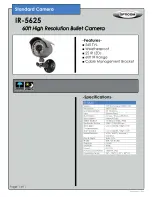
1
SM103
DOOR/WINDOW DETECTOR
The Door/Window Detector is a Z-Wave
TM
enabled device and is fully compatible
with any Z-Wave
TM
enabled network. Z-Wave
TM
enabled devices displaying the
Z-Wave
TM
logo can also be used with it regardless of the manufacturer, and ours
can also be used in other manufacturer’s Z-Wave
TM
enabled networks. Inclusion
of this Door/Window Detector on other manufacturer’s Wireless Controller menu
allows remote turn-on of connected modules and their connected lighting when the
Detector is triggered.
Adding to Z-Wave
TM
Network
In the rear casing, there is a tamper switch which is used to carry out inclusion,
exclusion or association. Put a Z-Wave
TM
Wireless Controller into
inclusion/exclusion mode, press the tamper switch on the detector to complete the
inclusion/exclusion process.
Choosing A Mounting Location
The Door/Window Detector is suitable for mounting in dry interior locations only.
Decide which doors/windows are to be protected by Door/Window Detectors,
(usually the front and back doors as a minimum will have Door/Window Detectors
fitted). Additional detectors may also be fitted where required to other vulnerable
doors or windows, (e.g. garage, patio/conservatory doors etc).
Note
: Take care when fixing the Detector to a metal frame, or mounting within 1m of
metalwork (i.e. radiators, water pipes, etc) as this could affect the radio range of the
device. If required, it may be necessary to space the magnet and detector away
from the metal surface using a plastic or wooden spacer to achieve the necessary
radio range.
Installation
1. Undo and remove the fixing screw from the bottom edge of the Detector.
Remove the rear cover.
2. Fit 3 1.5V AAA batteries supplied to the battery compartment.
3. With the tamper switch not being pressed on the Detector, detach or close the
magnet from the Detector, the LED on the Detector will illuminate.
4. Using the rear cover as a template, mark the positions of fixing holes on the
fixed part of the frame along the opening edge opposite the hinges using
screws provided.
5. Refit the Detector to the rear cover and secure with the fixing screw supplied.
Do not over tighten the fixing screws as this may distort or damage the casing.
6. Fit the Magnet to the moving part of the door/window opposite the Detector
using the adhesive tape or 19mm fixing screws.
Ensure that the parallel gap between the Magnet and Detector is less than
10mm and that the matching line on the Magnet is pointing towards and aligned
with the line on the Detector.
7. If several windows need to be protected, adopt the wire according to the
specifications as mentioned below. This should be wired to the terminal block
provided in the battery compartment in series connection. The wired contact
should be connected using two core (24AWG) wire of maximum length 4m.
A cable entry cut-out is available and adjacent to the terminal block.
Tamper Switch





















